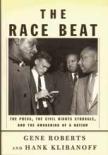Media Shine a Light
In 1940, the Carnegie Foundation commissioned a study to assess the state of race relations in America, segregation and white supremacy in the South. The Foundation chose a Swedish sociologist named Gunnar Myrdal to lead the project. They selected a non-American scholar because they wanted an outsider’s perspective on the problem.
Myrdal spent the winter of 1940 in the United States interviewing, visiting and talking with people throughout the South. The poverty and discrimination he encountered shocked him. Myrdal believed that exposing the second-class status of African-Americans would provoke a response by Americans.
To get publicity is of the highest strategic importance to the Negro people, Myrdal wrote in his final 1,483-page report, which was published in 1944 under the title An American Dilemma.
The Race Beat: The Press, the Civil Rights Struggle, and the Awakening of a Nation, tells the story of how the press focused public attention on the race problem and the civil rights struggle after years of ignoring it. Gene Roberts and Hank Klibanoff, two veteran reporters who covered many of the civil rights protests for The New York Times and The Atlanta Journal-Constitution, have written a masterly history and assessment of the press’s performance during the major campaigns of the civil rights movement. The book covers the period from 1955 through 1968. The authors have earned a place alongside other prize-winning chroniclers of that time like Taylor Branch, Garry Wills and David Halberstam.
One of the book’s strengths is that it begins by recognizing the work of the Negro press. We learn about the editors who assigned reporters to cover the racial strife impacting their African-American readers throughout the South long before most white editors considered it a serious story. The authors single out individuals like John H. Murphy Sr., publisher of The Baltimore Afro-American; Robert S. Abbott, a Georgia-born lawyer who created The Chicago Defender, whose weekly circulation reached 230,000 by 1915; and P.B. Young, publisher of The Journal and Guide in Norfolk, Va.
But all the warning, all the harbingers, all the reports exploded onto the pages of Negro newspapers, write Roberts and Klibanoff. Across the South, almost without limitation, Negroes had access to Black weeklies that ridiculed white hypocrisy, spoke out bitterly against racial injustice, reinterpreted the mainstream press and covered Negro social and religious organizations in detail.
One of the first reporters assigned full time to the race beat was Simeon Book, Washington bureau chief for Ebony and Jet Magazines, two of the highest circulation Negro publications in the country. Book belonged to a small group of African-American reporters who shared rooms in private homes while working competitively for stories in the South.
Even before it was clear that all the datelines, taken together, constituted a civil rights movement, it had become clear in the Negro press that the race story had developed into something constant and enduring.... It had become the race beat and the Negro press was seriously staffing it. When, if ever, would the northern press join in?
The tragic event that galvanized the white and mainstream press was the murder of 14-year-old Emmett Till in the summer of 1955. Till was beaten to death while visiting his great uncle Moses Wright in the town of Money, Miss., for allegedly whistling at a white woman. The trial of the men accused of killing him brought the national media to the South in large numbers for the first time, according to the authors: In his death, Emmett Till not only brought Negro reporters into the heart of the white man’s kingdom—the courtroom—but he brought white reporters into the deep South in unprecedented numbers to cover a racial story.
The new medium of broadcast television would dramatically expand the audience seeing for the first time the ugliness and violence that African-Americans confronted as a regular part of their nonviolent advocacy for civil rights.
One of the most famous pictures broadcast to American homes in the spring of 1963 originated in the streets of Birmingham, Ala. Sheriff Eugene Connor (sometimes known as Bull) ordered firefighters and police to attack children and adults marching peacefully through the streets with police dogs and water sprayed from fire hoses.
The police response and the images it produced had an instant impact in the two places where it mattered most, Birmingham and Washington, the authors write.
Congressman John Lewis of Georgia, a veteran of many of that era’s most violent battles, remembers how hard the segregationists worked to obstruct the role of public watchdog played by print and broadcast reporters.
He can recall the security he felt when reporters—'sympathetic referees,' he calls them—were watching and the fear he felt when they weren’t.
Lewis tells Roberts and Klibanoff that he believes that the civil rights movement would not have achieved its victories without the roving eyes and ear of the press.
If it hadn’t been for the media—the print media and television—the civil rights movement would have been like a bird without wings, a choir without a song.
This article also appeared in print, under the headline “Media Shine a Light,” in the February 12, 2007, issue.








